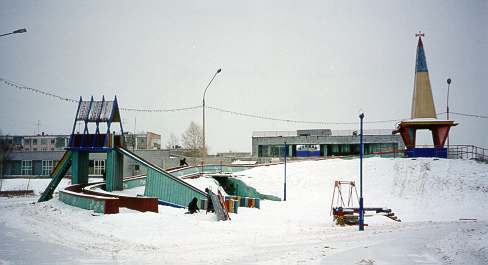The city of Bratsk
Last updated: 16.4.2002
A children playground with tunnels, slides and colorful structures.
Dec. 5, 2001

The name of Bratsk means a place where Buryats live (Bratsi in the 17th century Russian). The first Europeans came to this place in 1623. It was a unit of 40 soldiers sent there to find out whether one could impose a tax on the Buryats living there (see the history of Bratsk, in Russian). In 1636, the first fort was built there at the confluence of the Oka and Angara rivers to enforce the tax collection from natives. In 1640's there were already some peasants at the fort growing crops. In 1690, a monastery was built at the fort. In 1702, there were 15 communities in the Bratsk area with 128 homesteads. In 1805, the newly established Bratsk komissarstvo (administrative unit) had 5210 inhabitants. In 1910, there were 60 communities with 14,006 people (including 5596 political exilees!). In 1948, the regional centre, the old village of Bratsk, had 2247 inhabitants.
In 1954 it was decided to build the Bratsk dam and the hydroelectric station. After that a large influx of new inhabitants started. During their first year there, many of them had to live in tents. The present day Bratsk is a big industrial city with more than 275 thousand inhabitants. It is spread on 43,000 hectares (106,250 acres) of land. Its various parts are separated by a lot of empty space. Most older buildings in the city are large apartment blocks. With the exception of the compact centre, there are often big gaps between them, which sometimes invokes the feeling of an unfinished city. However, the city administrative tries to gradually beautify the city. Each year they choose another part of the city where new trees are planted and parks established.
On the outskirts of the city, new subdivisions of single-family houses, most of them built of red brick, or the combination of brick and wood, have been mushrooming recently.
The Bratsk hydro station was the largest in the world when finished in 1961. Since then, it feeds many industrial enterprises. The largest one is the largest aluminium producer in the world, the Bratsk Aluminium Smelter. Its workers bring home salaries that are well above the average, but so is the discipline required from them (e.g., no smoking at all on the job, no trace of alcohol in their breath in the morning), and many pay for the high salaries by respiratory problems caused by tiny aluminium particles. To get some relieve, they have very long paid vacations every year, but even so some of them have to retire from this work in their 40's. When the world demand for aluminium sharply decreased after the September 11, 2001 terrorist attacks in the USA, the company cut the salaries of all its workers by almost one third, rather then lay off some of them. Recently (spring 2002), some of the cutbacks may be finally reversed as the demand for aluminium is picking up again.
The smelter is of course not only the source of wealth, but also of the air pollution for the entire the city. The severity of the problem depends on the wind direction. When I was there, very tiny round snowflakes were falling almost non-stop all the time. I was told that such flakes arise by condensation of moisture on the tiny particles released from the smelter.
The summers are said to be beautiful in the Bratsk area. Most people have cottages outside of the city, where there are spending in the summer as much time as they can, growing their vegetables, fishing, picking up berries and mushrooms.
Unlike in Moscow, where most of the street names reminding the communist area have been changed since 1990, in Bratsk (and also inIrkutsk and Ulan-Ude), the street names remained mostly unchanged. Also the Lenin statues are still there. Originally the Siberian cities simply could not afford the large expenses incurred by renaming most of the city streets (and thus the addresses of all the institutions and companies). Now they came to the conclusion, that the old names and statues are part of their history that cannot be overwritten. Especially the statues could eventually become big tourist attractions.